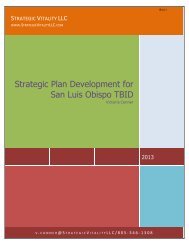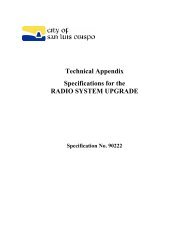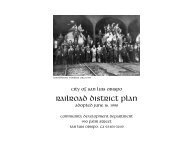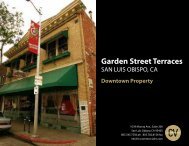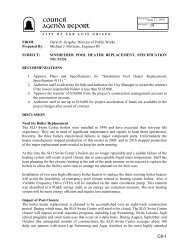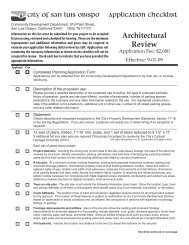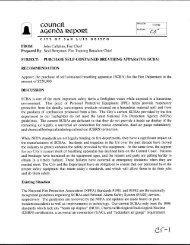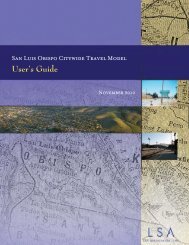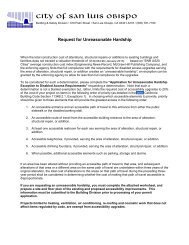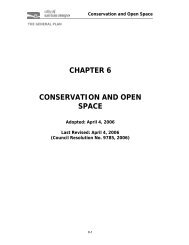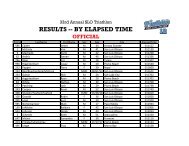Drainage Design Manual - the City of San Luis Obispo
Drainage Design Manual - the City of San Luis Obispo
Drainage Design Manual - the City of San Luis Obispo
You also want an ePaper? Increase the reach of your titles
YUMPU automatically turns print PDFs into web optimized ePapers that Google loves.
GRADING OF ROCK SLOPE PROTECTION PERCENTAGE LARGER THANSTANDARDRock SIZEor Rock MASSor Rock WEIGHTRSP-Classes [A]Method A Placement: Larger RSPMethod B Placement: smaller RSPRSP-Classes o<strong>the</strong>r than BackingBacking No.25 lb 11 kg 95-10090-100 25-750-55 lb 2.2 kg 90-10025-751 lb 0.4 kg 90-100[A][B]US customary names (units) <strong>of</strong> RSP-Classes listed above SI names, Example US is “2 ton” metric is “2 T”.“Facing” has same gradation as “Backing No. 1". To conserve space “Facing” is not shown.Example for determining RSP-Class <strong>of</strong> outside layer. By using Equation 1, if <strong>the</strong> calculated W=135 kg (minimum stablerock size):1. Enter table at left and select closest value <strong>of</strong> STANDARD Rock SIZE which is greater than calculated W, in thiscase 220 kg2. Trace to right and locate “50-100" entry3. Trace upward and read column heading “1/4 T”, <strong>the</strong>n 1/4 T is first trial RSP-Class.6.7.5 Determine <strong>the</strong> Required Layers <strong>of</strong> RSPInexperienced designers sometimes use Table 6-3 and specify all <strong>the</strong> RSP-Classes between <strong>the</strong>"final selection" outside RSP layer and Backing No. 3. To avoid this pitfall, use Table 6-4,California Layered RSP. Standard designs include RSP-fabric, Backing Class, Inner, andOutside layers <strong>of</strong> RSP as shown. In Table 6-4, in conformance with filtration <strong>the</strong>ory, from <strong>the</strong>bank to <strong>the</strong> stream, each layer was designed progressively larger, so an inner layer will not passthrough voids <strong>of</strong> <strong>the</strong> next layer. The thickness <strong>of</strong> <strong>the</strong> entire cross section is reduced and lesscostly when RSP-fabric replaces Backing No. 3. Do not arbitrarily eliminate RSP-fabric. If youdo not use RSP-fabric, <strong>the</strong>n 230 mm <strong>of</strong> Backing No. 3 is normally required as <strong>the</strong> initial "filterseparator"layer, and it is placed directly on <strong>the</strong> bank to be protected. If Backing No. 3 isrounded, river-run material, <strong>the</strong>n <strong>the</strong> steepest allowable slope angle should be 1V:2.5H, contraryto <strong>the</strong> recommended 1V:2H <strong>of</strong> <strong>the</strong> Caltrans Standard Specifications.An example using RSP-fabric is: Type B RSP-fabric is placed directly on <strong>the</strong> bank as <strong>the</strong> initial"filter-separator" material, <strong>the</strong> inner layer is Light, and <strong>the</strong> outside layer is 1T. Notice that inTable 6-4, when <strong>the</strong> outside layer is 1T or larger <strong>the</strong>re is more than one possible design for innerlayers. Each design satisfies filtration <strong>the</strong>ory, that is, underlying layers are retained. Rockavailability and/or cost <strong>of</strong> producing one design versus ano<strong>the</strong>r may determine which RSPclassesare selected as inner layers. Or on ano<strong>the</strong>r part <strong>of</strong> a project <strong>the</strong>re may already be aspecified inner RSP-class, and ra<strong>the</strong>r than introducing ano<strong>the</strong>r inner RSP-class, use <strong>the</strong> one thatis already specified.SLO Creek <strong>Drainage</strong> <strong>Design</strong> <strong>Manual</strong> 81 February 2003



